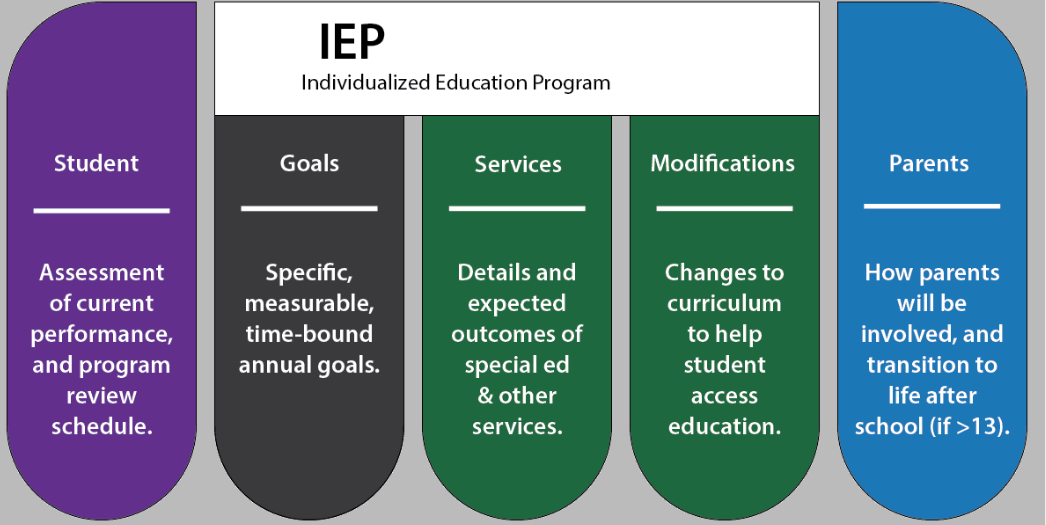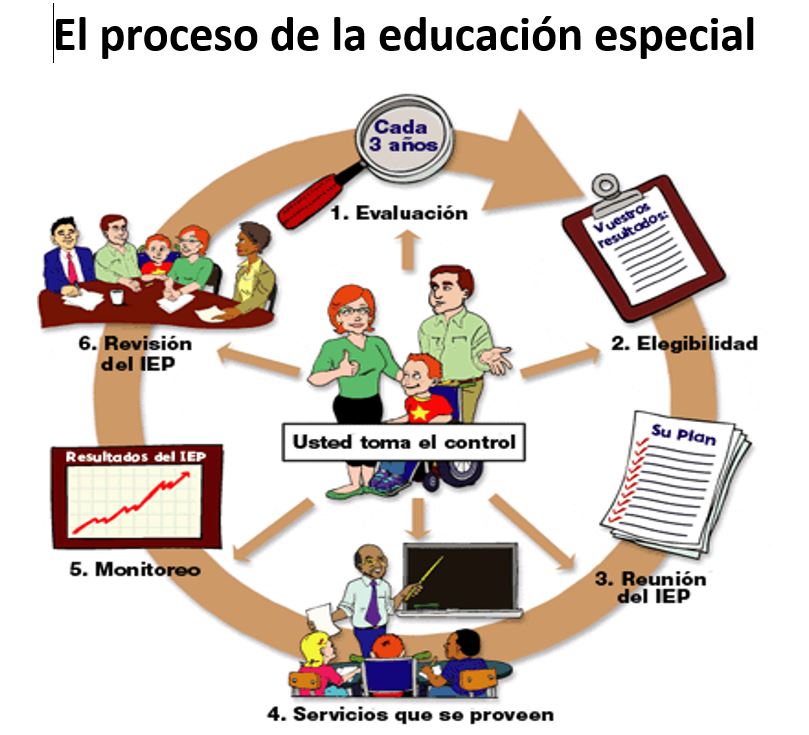- Individualized Education Program (IEP) -
Share On:
What is an Independent Educational Plan (IEP)?
An Individualized Education Program (IEP) is a legal written plan outlining a student's specific educational needs, goals, and services, developed and reviewed following federal law.
The IEP includes information about the student’s strengths, needs, and goals. Importantly, the document identifies the special education and related services to be provided to help the student make progress in school.
Depending on the needs of the particular student, the kinds of services available are: adaptive physical education, assistive technology, behavioral support, counseling, occupational therapy, specialized instruction, speech and language therapy, and transportation.
The IEP is created by a team that includes the student’s parents, teachers, and other professionals who work with the student. The IEP is reviewed and updated on an annual basis at an IEP meeting, or more frequently if needed.
It is a collaborative document developed by school personnel, service providers, and the student's family, and is reviewed and updated periodically.
If your child attends a private school, note that private schools are not legally obligated to provide special education support services, unlike public schools. However, you can still reach out to your school district to initiate the IEP process. Some school districts may have limited funds designated to support services to private school students, but this availability is not guaranteed.
Here's a more detailed explanation:

- Purpose and Benefit:
The IEP aims to ensure that students with disabilities receive a free, appropriate public education in the least restrictive environment, as mandated by the Individuals with Disabilities Education Act (IDEA).
The main purpose of an IEP is simply to help a student with disability do better at school by providing them with extra support. We want students with special education needs to do better on multiple fronts, such as improving their:
- ability to access the curriculum and participate in school activities
- ability to communicate and interact with their peers and adults
- ability to function in other areas of their life, like physical and occupational therapy goals
- behavior and ability to follow classroom rules and expectations
- grades in specific subjects or overall
- progress towards graduation, or other academic or career goals
- reading and writing skills.
The IEP includes an assessment of the student’s position and has specific actionable goals. It’s reviewed and updated on an annual basis, or more frequently if needed, to ensure the child’s needs are being met and that they’re making progress towards their goals.
IEPs offer several benefits:
- Legal protection for students and families.
- Involvement of families in decision-making about their child's education.
- Specific supports and services tailored to the student's individual needs.
- Content
An IEP typically includes:
- The student's present levels of academic and functional performance.
- Measurable annual goals and short-term objectives.
- Specific educational services and supports, including accommodations and modifications.
- A description of how the student's progress will be measured and reported.
- Information about the student's placement in the educational program.
- Development:
The IEP is developed through a collaborative process involving:
- The student's parents.
- School representatives, including special education teachers, general education teachers, and administrators.
- Related service providers, such as therapists or counselors.
- The student (when appropriate).
- Review and Revision:
IEPs are reviewed at least annually to assess the student's progress and make necessary adjustments to the plan. But changes and modifications can be made at any time basis on the student’s advancement. It can be requested my teachers, parents or therapies.
- Services:
Services can be provided in various settings, including:
- General education classrooms with accommodations and modifications.
- Small group instruction in a separate setting.
- Specialized classrooms or schools for students with more intensive needs.
- Key Elements:
In an IEP document, you will typically find each of these key elements.
- Student’s current strengths, needs, and level of performance. A detailed assessment of the child’s current abilities, including their academic, social, and behavioral strengths and needs.
- Measurable annual goals. Specific, measurable, and time-bound annual goals that are aligned with the student’s needs and that will help them make progress in school.
- Special education and related services. The special education and related services to be provided to the student, including the type and frequency of services, the location where services will be provided, and the expected outcomes of the services.
- Accommodations and modifications. Any accommodations or modifications that the child may need in order to access the curriculum and participate in school activities.
- Transition plan. If the student is 14 years or older, the IEP should include a transition plan that outlines the steps the child and the school will take to prepare the student for life after high school, including post-secondary education, employment, and independent living.
- Parental involvement. A statement of how the parents will be involved in the child’s education, as well as their rights under the IDEA.
- Regular review and updates. A schedule for regular review and updates, typically at least once a year, or more frequently as needed.
The elements of an IEP may vary depending on the jurisdiction or the specific needs of the student. But these are the key elements that are commonly included in IEPs.
- Related Services:
- Special education and related services that may be provided to a student as part of their IEP include:
- Adaptive physical education.PE instruction is adapted to meet the student’s physical needs or abilities.
- Assistive technology.Devices or software that can help the student with communication, organization, or other tasks.
- Behavioral support.Strategies or interventions to help positive behavioral interventions, strategies, and supports, to address behaviors that interfere with the child’s learning or that of others. The idea if for the student manage their behavior and improve their social skills.
- Talk sessions to help the child with emotional or social issues.
- Occupational therapy.Physical therapy to help the student improve their fine motor skills, self-care skills, or sensory processing.
- Specialized instruction. One-on-one or small group instruction, or instruction that is adapted to meet the student’s specific needs.
- Speech and language therapy.Therapy to help the student improve their communication skills or address speech or language disorders.
- Transport to and from school or to and from related services.
- The IDEA does not specify a funding limit on support services in an IEP. However, it does require the services be sufficient to provide a meaningful educational benefit, and that they’re provided at no cost to parents. Funding for special education and related services is typically limited by the budget allocated to the school district.
It’s important to note that the specific services provided to a student will depend on their individual needs and goals as outlined in their IEP.
- Curriculum Adjustments: To help a student with a disability access the curriculum and participate in school activities, accommodations and modifications to the curriculum may be made. These could include things like:
- Adapt testing. Give the test in an alternative format, such as an audio or Braille version, or allow extra time to complete the test.
- Adapt the curriculum. Simplify the language or concepts used in the curriculum, or provide alternative materials that are more accessible to the student.
- Additional support. Provide a tutor, a note-taker, or other support services to help the student succeed.
- Modify teaching methods. Use hands-on materials, visual aids, or other strategies to help the student understand the material.
- Provide extra time. Give the student extra time to complete assignments, tests, or other activities.

The specific accommodations and modifications will depend on the student’s needs and goals as outlined in their IEP. The list is not exhaustive and could be very different depending on the child’s unique requirements.
- Transition Services:
Services that help students with disabilities prepare for life after high school, including career and college counseling, and training in independent living skills.
- State Special Schools:
California operates three State Special Schools for students who are blind, visually impaired, or deaf, providing specialized services for these students.
- California Department of Education (CDE):
The CDE provides state leadership and policy direction for school district programs and services for students with disabilities.
The process for starting an IEP varies depending on the state or jurisdiction. But, generally, the process involves the following steps, beginning with a referral for an evaluation.
- A referral for an evaluation for special education services can come from a parent, teacher, or other school staff member. The referral should include information about the student’s strengths and needs, as well as any concerns about the student’s performance in school.
- Once a referral is received, the school district will evaluate to determine if the student has a disability and if they need special ed services to make progress in school. The evaluation will include assessments in areas such as academics, behavior, and any other areas that are related to the student’s suspected disability.
- Eligibility determination. After the evaluation is completed, the school district will determine if the student is eligible for special education services. If the student is found eligible, the school district will develop an IEP.
- IEP team meeting. The school district will schedule an IEP meeting to develop the program. The team will include the student’s parents, teachers, and other professionals who work with the student. They’ll review the results of the evaluation and determine the student’s strengths, needs, goals, and the special education and related services that will be provided to the student to help them make progress in school.
- After the program is developed, the school district will implement it and provide the student with special education and related services. The school district will also provide the student’s parents with a copy of the document.
- Review and update.The IEP will be reviewed and updated on an annual basis, or more frequently if needed, to ensure that the student’s needs are being met and that they are making progress towards their goals. The IEP team, which includes the student’s parents, teachers, and other professionals, will review the student’s progress and make any necessary changes.
The whole point of an IEP is to make school life, and therefore life in general, better for a child with a disability.
How to Contact Us
Hablamos Español
PHONE: (949) 326- 6612
EMAIL:
controlmyiep@gmail.com
ADDRESS:

600 W Santa Ana Blvd, Suite 206, Santa Ana, CA 92701
Across from The Federal Building
HOURS:
Monday - Friday: 9 AM-5 PM Saturday-Sunday: Closed
Control My IEP is ready to assist you, per your request. Give us a call at (949) 326-6612 or submit the contact form.
